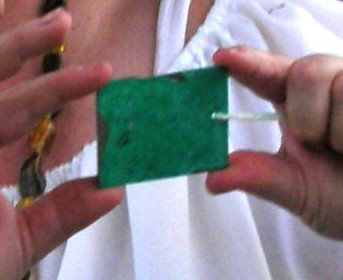
Today, I continued with my learning about cheese. Luckily, the baroness is teaching me via email and phone. Between my car and her bum foot, we are both stuck at home. It isn't so bad. I am learning a lot. The haloumi and teleme are pressing in the refridgerator and I am boiling down the mysost as we speak.
It has to reduce by 75% before the next step. That is taking a lot longer than I expected because of the electric stove. I will probably be editing this post as I go. I am excited about this because it is a whey based cheese instead of a milk based cheese.

Well, you knew it was coming Susan. Yes! Time to make ink! I found an old iron pipe that was not galvanized and set about soaking it in some old urine. The recipe prefers first morning urine, but I actually am running low on that and saving it for other projects. It should be done in a stoneware jar, but I do not have those either.
I decided to cruise around the internet and find out where I got this recipe. It was at the time when all of my search came from the internet. I remember it because when I was at Penssic a few years back, I asked a merchant about it. He pulled out a manuscript that had been eatten away by the ink. He thought the one he had was an iron gall ink. Anyhow, he said urine-based would do the same thing only faster.
On another note, Magge and Graywolfe gave me Caroline Holmes The Not So Little Book of Dung which was just released. It has interesting pictures and I will review it after I read it.
__________________________________
Ok, so on to the collection of internet notes... (For those of you who are new, I paste notes in here and links so I can look them up later.) Every time I look for notes on why I am doing something, I find a gazillion more links that show how little I know.
__________________________________
Red ochre, the most common red pigment, was rarely used in manuscripts, but commonly used in wall painting. Vermillion was obtained from cinnabar, or through a chemical reaction of heating mercury and sulfur together to produce mercuric sulphide. Mixed with white lead it formed a flesh color, olchus or membrana. Red lead, minium or sandaraca, was prepared by heating white lead for several days. It was necessary to stir the pot every two hours, and it was suggested that one forego sleep for several days. It was recommended that vermillion be added to the lead to make it more brilliant. Brazil wood dye was the most useful red pigment for manuscripts. Wood shavings were soaked in a solution of lye, wine, or urine for several hours and then alum was added. The intensity of the color was a result of the quantity of alum added. Pigment was mixed with glair for red ink or for glazing over illumination. It could be precipitated into a powder and then mixed with gum to be made into paint. Purple was derived from a mixture of azurite and brazil wood, or the juice of bilberries and alum. A common purple pigment was folium, derived from the seeds of turnsole. It was used in the form of clothlets, and cheese glue was used as a medium. White was obtained by the use of white lead even though it was poisonous and turned black in the presence of certain other pigments. It was made by placing plates or strips of lead above vinegar. The white lead was scraped off, and wine was used as a medium. It could not be mixed with vermillion or orpiment, and so in those instances other white pigments such as ground bones or egg shells were used. Orpiment (an arsenic compound) was widely used for yellow, even though it was poisonous and rather coarse. Because it was so coarse it was customary to add another pigment, yellow ochre, to it which would give the painted surface a smoother appearance. Yellow ochre was rarely used by itself in manuscripts, as it was more appropriate for wall painting. Saffron was also used to produce a yellow pigment, though it was not permanent.http://web.ku.edu/~bookhist/medbook1.html
Oh and lookie!!! Persians! I need to bring this up with Master Jim. I don't think I can get mango leaves so I will see if the substance is available in India. This is also a serious published study and a must have for the collection. Journal of American Institute for Conservation 1991, Volume 30, Number 2, Article 2 (pp. 125 to 144)
Organic yellow pigments were not found in this analysis, but they may have been used. Indian yellow, a brilliant, stable, yellow pigment prepared in Bengal from the urine of cows fed on mango leaves, may have been used by Persian painters. Saffron, a rich golden yellow powder from the flower of the plant, Crocus sativa, that was cultivated from Sassanian times in Iran, probably could have served directly as a pigment (Laufer 1919, 320). The Persian painters may have found this powder particularly useful in combination with gold pigment. Because saffron has always been dear, less expensive colors such as the orange from safflower (Carthamus tinctorius) or the yellow from shoots and roots of tumeric (Curcuma domestica and Curcuma longa) were often combined with saffron as adulterants (Laufer 1919, 309–10; Wulff 1966, 191). Wulff (1961) has indicated that both colors were employed in Persian textile production as well. Iranian textile dyers employed yet another yellow prepared from Persian berries (Rhamnus infectorius) as a lake; it might have been used as a pigment, too.http://aic.stanford.edu/jaic/articles/jaic30-02-002.html

No comments:
Post a Comment